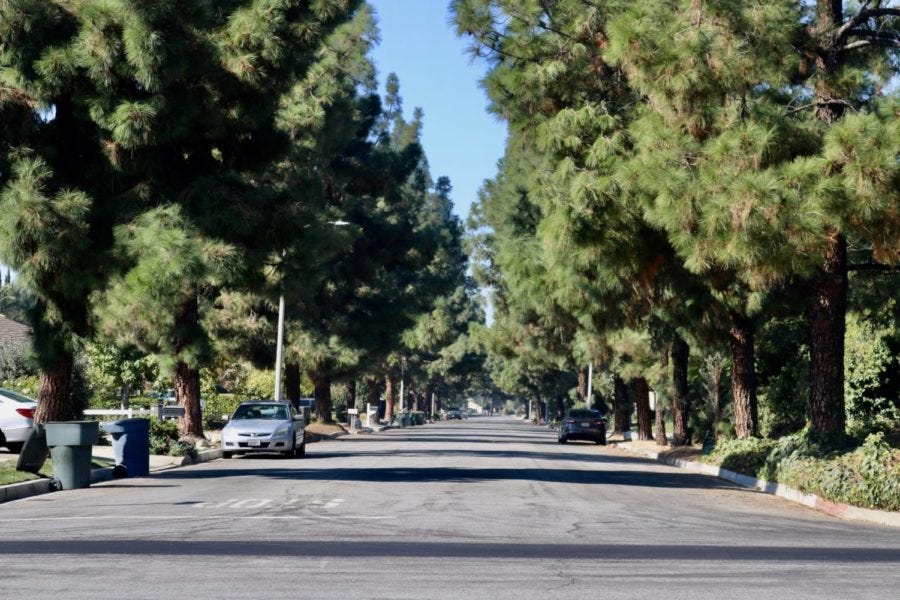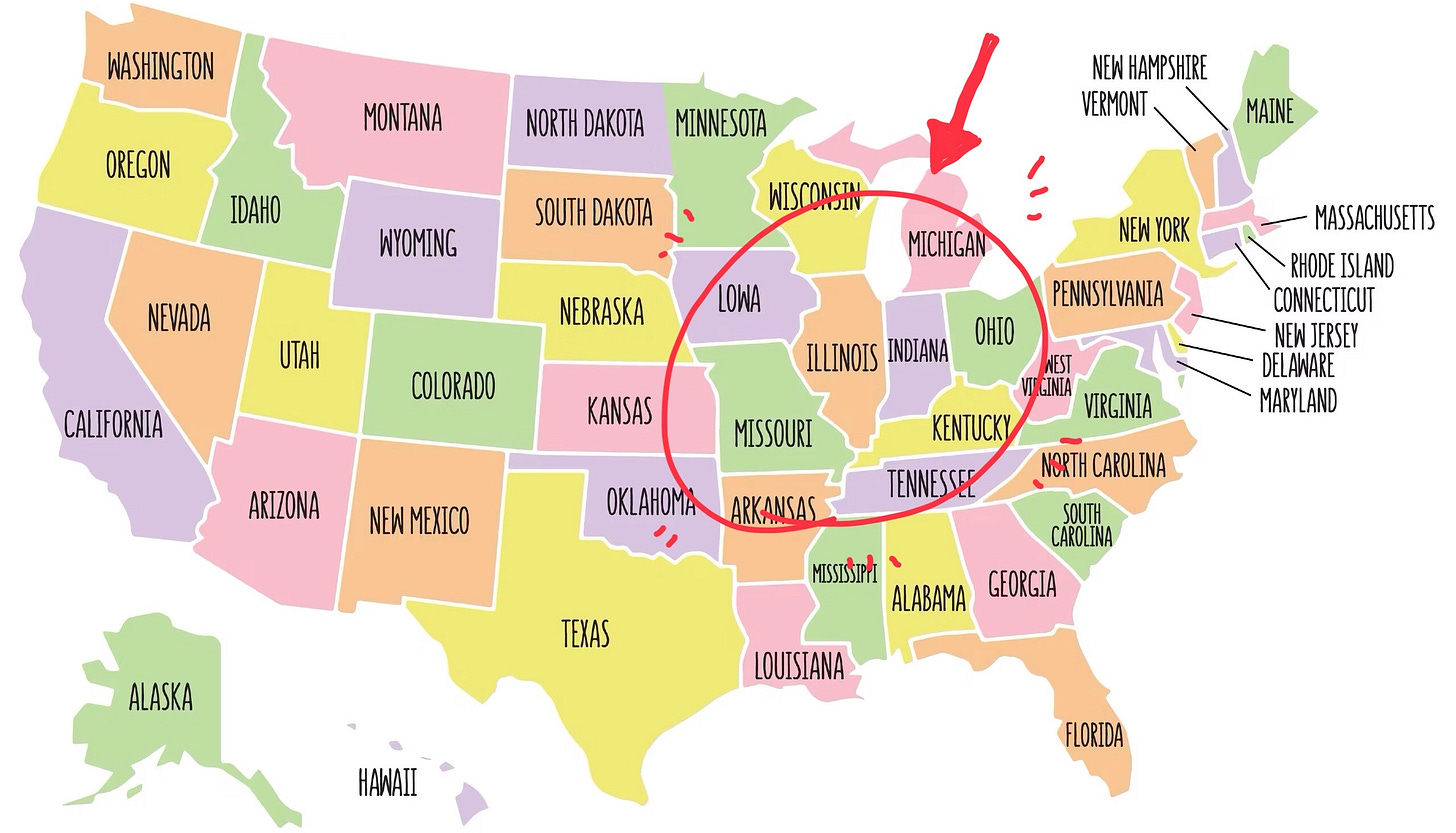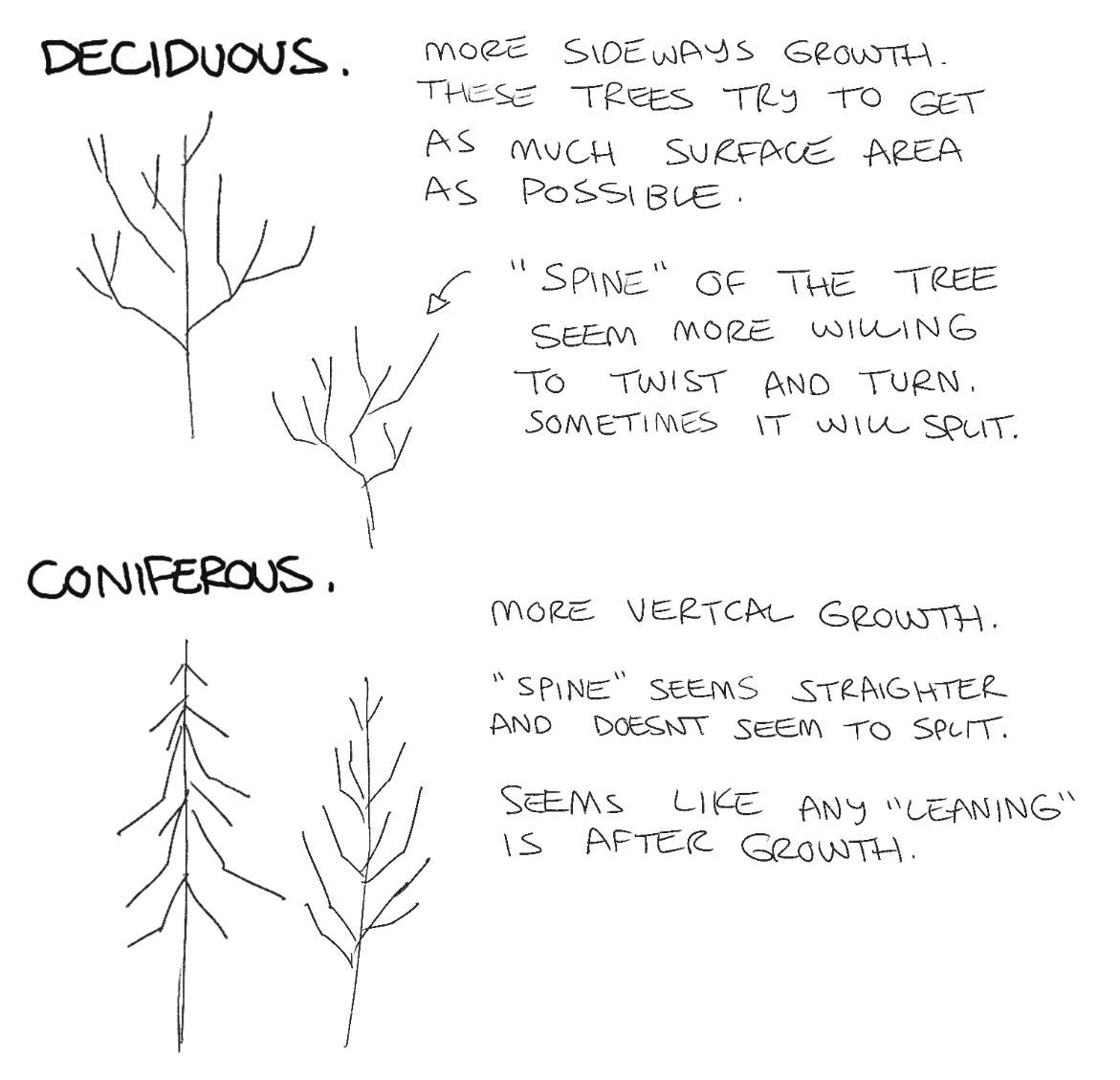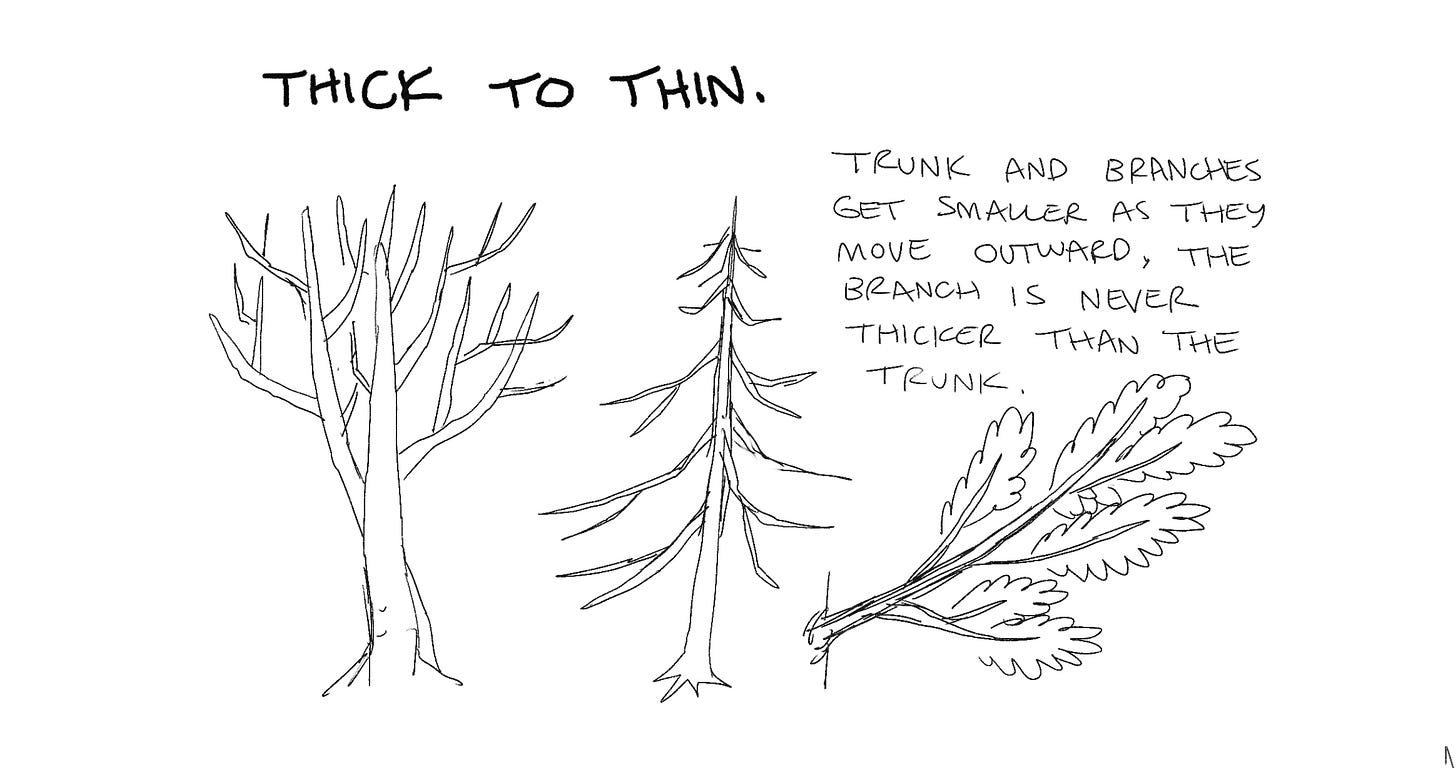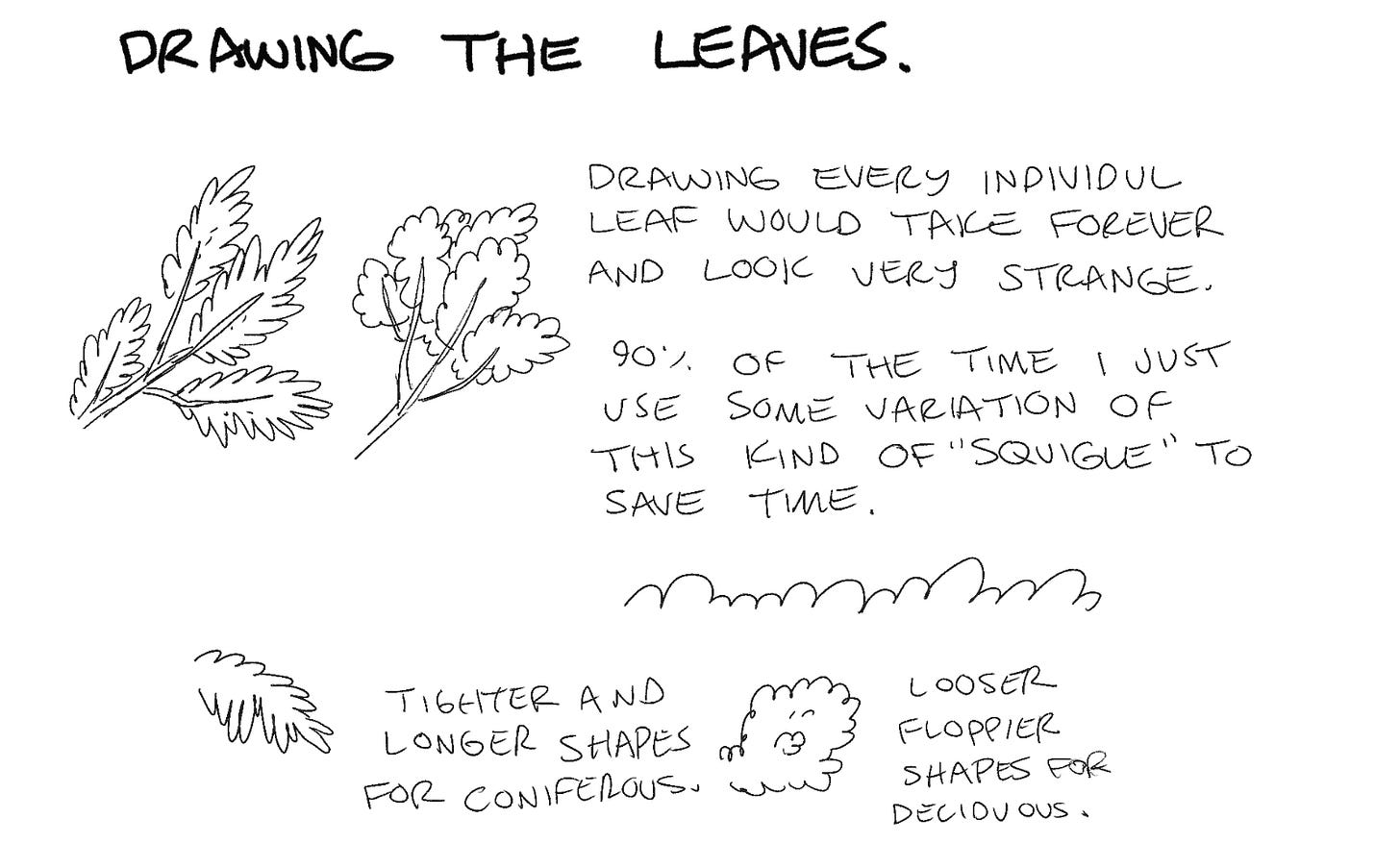You may have noticed some additional attention to the trees in my art lately. I have put a lot of thought into it and wanted to write out what I am thinking before I totally internalize it and forget why I am making decisions. This was going to be on the premium feed, but I wanted to send it out to everyone to hopefully coax some people to sign up and help me raise cash to hire a colorist. (We are now at 17 from 12. Thank you!)
Subscribers will get some additional stuff and the fresh uncolored Aminals pages after this goes out.
If you want access and genuinely can’t afford it EMAIL ME. Times are weird and hard. I will get you a code to get access no questions asked. Just pink promise to support me down the line if you can!
Why care about trees?
I don’t know if you’ve been outside lately, but these things are EVERYWHERE. One of the worms that’s gotten into my brain about comics lately is that as much of the comic should be as “good” as the other parts as possible. Nothing is ever perfect and there is too much to learn to get that totally right. But it is WEIRD when you see a well rendered character in front of a floppy car or a character with near perfect anatomy in front of a classic comic strip cartoon tree.
As my characters have started looking better, I’ve realized I need to put in that same effort on EVERYTHING. And one of the most common things besides people are trees. I think this choice has been a good one for me for a whole list of reasons. Here are some of those reasons.
Trees are everywhere. You would have to make a conscious decision to NOT draw them. If you are drawing a random location it is more likely they belong there than almost any other subject you can pick to draw.
They are a very easy solution to layout and composition issues. Dead area in a background you need to fill? Tree. Need a line to direct the eye to a specific point? Tree. Need to just generate noise to make a subject in front of it “pop”? Tree. Need a small thing? Tree. Need a massive thing? Tree.
They very quickly communicate time of year and location with one subject. In comics the more you can say visually the better. The kinds of trees you pick can tell you more about the environment than anything else. They react to weather and conditions and climate in an extremely visual way.
Honestly, they are just fast to draw and get some impressive detail on the page in a rush once you get it down. Sometimes you only have an hour and NEED something wild. It’s easier to bust out a wild tree than a house or something because they are more organic and things like perspective can be SOMEWHAT looser.
Kinds of Trees.
I am going to be honest. I don’t know anything about trees yet. There are thousands of different kinds and I am still learning. At the current moment in my brain there are two “kinds” of trees. Deciduous and Coniferous.
Deciduous are the classic kind of trees. They are more “spread out” and bushy. From what I understand anything with a broad leaf is this. This is the classic simple stick with a circle on top.
Coniferous are the kinds of trees with the tiny spikey leaves that start wider at the bottom and get consistently thinner on the way up. You know, Christmas trees. This is the classic stick with a triangle on top.
What kind you are choosing to draw in a panel is important. If you are drawing a more downtown area, it’s almost never going to have a coniferous tree in it be design.
The presence of coniferous trees tends to “say” you are closer to the edge of town or the wilderness. I am not entirely clear on why they tend to grow this way. It might be a choice we make as humans, and it might just be environmental factors. Your choices are saying things about the drawing that are pretty important. Once you put conifers into a developed landscape it BECOMES certain regions.
I have a series of cities and regions I use as keywords when looking up references for Everything Sucks. And it’s not just trees. If you are drawing a house in a super wet climate with strange soil, you should know nobody is going to have a basement. There is a sentence I repeat a lot to myself and the people I work with but “Writing is less about making decisions and more about asking questions.”
Once you make the few key decisions and start movement 99% of your options don’t exist anymore.
To keep my options a little more open Everything Sucks exists in a broader region than a more grounded story has too. But as I make more decisions, future potential options will narrow and this circle will shrink. If I show that every winter has deep snow, a lot of this goes away. Every choice chisels it down and defines what it is.
The Tree Skeleton.
Now that the stuff you didn’t ask for is done (that you needed to hear if it wasn’t obvious), I am going to go through the parts of how I think about the tree and at the end show how I actually draw them in practice.
The main thing is the overall shape. I draw the “chunks” of leaves and the branches separately. For a long time I would draw the outside of the giant chunk of leaves on top of the tree first, and then work backwards, and I still do this sometimes. But a lot of the time the shape of the branches is harder to get looking right and doing that after drawing the leaves left me with some weird looking trees. So now I will usually draw these LOOSE skeletons up front, do the leaves, then draw out and adjust the other information after the fact.
When I am looking at references it is mostly for these shapes. I think getting these movements trees make alone will make 90% of badly drawn trees look cooler. I have been calling the “trunk” the spine in my head and I think switching these up with different shapes is a big deal.
The tree spine connects to the, branches.
I am not a scientist, but I am 99% sure the purposes of branches is to put leaves above other things and in front of the sun. When you are deep in a thick forest the branches are usually super high over head. So The position of the branches is going to be vaguely towards the sky, and reaching away from other big things (including other trees) that would block light from hitting them. So if a big tree is right next to a house, the branches are going to be trying to get “over” the the house to try and get as much of the light for as much of the day as possible.
This is very annoying because they like to break off and land on your roof. But it does look beautiful.
So I figure out the direction, then I figure out the size and shape. A lot of this is pretty random and intuitive. I am not spending the entire time thinking about this stuff, but anytime I feel likely unsure or the pencil stops moving I just go over it. Older trees seem to be more gnarly and inconsistent in their size/directions from time and wear, while younger trees seem to have more direct straight lines to towards the sky. I am sure there is some stuff I am going to learn that will make some of this feel stupid for missing, but for now it’s where I am at.
Broad Shapes
So the first step for my brain is figuring out the direction and shapes of things, and then I put the shapes and mass of the objects on top of those ideas. I draw everything in this same way. If I am very mentally tapped or struggling I will start with stick figure type drawings to show the direction of the shapes, but if I am feeling alert and things are working I can usually just draw the shapes without the lines to help me keep track of things. It all depends.
But it is very important to me that the drawings look like they have “mass” to them. When drawing the trees I tend to group these things into branches/trunks or chunks of leaves.
For the branches and trunk I will use a reference if I don’t like what happens naturally, but in general if I get a good idea for the movement it’s really about moving from large areas to small areas. I don’t think branches will ever be thicker than the base of the tree. So I will usually draw the middle part of the trunk before the branches start, and if that looks right I just make it larger towards the bottom and progressively smaller as I work my way up and out to the tips of the branches.
I am sure there is some kind of ratio or average for how quickly trees change shape and size as they grow, but I just guess. If it looks right I move on. I have drawn some trees that look kind of janky because this was wrong, but I also draw a lot of trees. It’s not worth taking the time to make any drawing perfect if it’s in a comic. If it sucks it sucks. You will get better as you go.
For the leaves I draw them in “bunches. I know it says it in the notes up there, but in case you can’t read my hand writing the more leaves you draw the stranger it’s going to look. Sometimes this can be good, but a lot of the times it will look goofy to draw too many. The exception to this is if the leaves are in the extreme foreground close to where the “viewer” would be. Drawing close up leaves detailed, and having less detail on the bunches as you get farther away is a SICK way to show distance.
I also draw bunches of leaves with one line usually with a weird squiggle motion. For conifers I will go deeper on the movement and do them closer together, but it’s the same thing.
Okay, substack says I am almost at the limit, so I will post the rest in the next few days or a week or whenever it gets done!
Love u,
Michael Sweater






